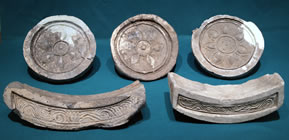


Tiles excavated from the Shinkyu kiln site
These are materials collected by the Archaeology Laboratory Faculty of Letters Rissho University through excavation surveys. Particularly noteworthy are the materials excavated during the "Archaeological Research on Ancient Ceramic Industries" project, which was carried out from 1958 to 1980 with funding from the Ministry of Education (now the Ministry of Education, Culture, Sports, Science and Technology).
The northernmost Maedanome kiln site in Aomori Prefecture, the Arasawa and Machisawada kiln sites in Dewa (Yamagata Prefecture), the Kanayama kiln site and Kamikotomo kiln site in Kamitsuke (Gunma Prefecture), Miyabora, Wakamiya, Mimakinoue, and Yae kiln sites in Shinano (Nagano Prefecture). On display are excavated items from the Yaehara kiln site, kiln sites such as Kamenohara, Shinnuma, Yamada, Miyanomae, and Mushikusayama in Musashi (Saitama Prefecture), the Aomizu kiln site in Bingo (Hiroshima Prefecture), and the Hirata kiln site in Chikuzen (Fukuoka Prefecture). All of these sites are known for providing valuable information on the state of ancient pottery production, the chronology of earthenware, and the supply problems of tile and mould.
Other artifacts on display include the Paleolithic Hotoku site in Hokkaido, the Asahi site in Kanagawa Prefecture, the Jomon period Ishigami shell mound in Saitama Prefecture, Yayoi period pottery excavated from Kugahara in Tokyo, the Nohara burial mound group in Saitama Prefecture from the Kofun period, the ruins of the ancient Nagakuma temple and Kujukubo temple in Chiba Prefecture, medieval ossuaries and stone monuments, and a single-character stone sutra excavated from the tomb of a member of the Tokugawa Shogunate at Zojoji Temple in Tokyo from the early modern period.
Others: Origen vessels and stone tablets excavated from southern Kanto, and sutra stones excavated from the tomb of the ninth shogun, Tokugawa Ieshige